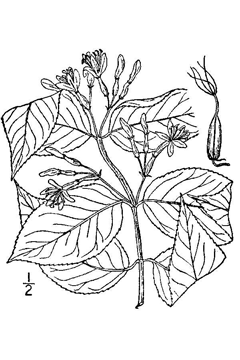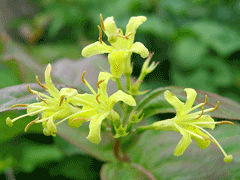 |
|
USDA-NRCS PLANTS Database / Britton, N.L., and A. Brown. 1913. An illustrated flora of the northern United States, Canada and the British Possessions. Vol. 3: 283. |
 |
| http://flickr.com/photos/70668033%40N00/ |
Translate this page:
Summary
Bloom Color: Yellow.
Main Bloom Time: Mid summer. Form: Spreading or horizontal.
Physical Characteristics

 Diervilla lonicera is a deciduous Shrub growing to 1 m (3ft 3in) by 1 m (3ft 3in) at a medium rate.
Diervilla lonicera is a deciduous Shrub growing to 1 m (3ft 3in) by 1 m (3ft 3in) at a medium rate.
See above for USDA hardiness. It is hardy to UK zone 3. It is in flower from July to August. The species is hermaphrodite (has both male and female organs).
Suitable for: light (sandy), medium (loamy) and heavy (clay) soils. Suitable pH: mildly acid, neutral and basic (mildly alkaline) soils. It can grow in semi-shade (light woodland) or no shade. It prefers moist soil.
UK Hardiness Map
US Hardiness Map
Synonyms
D. canadensis. Willd. D. humilis. Pers.
Plant Habitats
Woodland Garden Dappled Shade; Shady Edge;
Edible Uses
References More on Edible Uses
Medicinal Uses
Plants For A Future can not take any responsibility for any adverse effects from the use of plants. Always seek advice from a professional before using a plant medicinally.
Diuretic Galactogogue Laxative Narcotic Ophthalmic
The leaves are diuretic[257]. A compound decoction has been used in the treatment of stomach aches[257]. This contrasts with a report that the leaves contain a narcotic principle, inducing nausea[207]. The plant is used as a gargle in catarrhal angina[207]. The root is diuretic, galactogogue, laxative and ophthalmic[257]. A cooled infusion has been used as an eyewash for sore eyes[257]. The bark is laxative and ophthalmic[257]. An infusion has been used to increase milk flow in a nursing mother and as an eyewash for sore eyes[257].
References More on Medicinal Uses
The Bookshop: Edible Plant Books
Our Latest books on Perennial Plants For Food Forests and Permaculture Gardens in paperback or digital formats.

Edible Tropical Plants
Food Forest Plants for Hotter Conditions: 250+ Plants For Tropical Food Forests & Permaculture Gardens.
More

Edible Temperate Plants
Plants for Your Food Forest: 500 Plants for Temperate Food Forests & Permaculture Gardens.
More

More Books
PFAF have eight books available in paperback and digital formats. Browse the shop for more information.
Shop Now
Other Uses
Soil stabilization
The plants stoloniferous habit makes it useful for soil stabilization on banks and slopes[200].
Special Uses
References More on Other Uses
Cultivation details
Landscape Uses:Border, Container, Ground cover, Massing, Rock garden, Woodland garden. Succeeds in a moist fertile well-drained soil and is not fussy as to soil type[200]. Succeeds in full sun or partial shade[188]. Plants are hardy to about -30°c[200]. This species is a spreading suckering plant[11], it makes a useful understorey planting in woodlands[200]. Any pruning can be carried out in the winter or after flowering[188]. 2 or 3 year old stems can be removed in order to promote a more shapely bush[188]. Flowers are produced on the current seasons growth[11]. Plants in this genus are notably resistant to honey fungus[200]. Special Features:
North American native, Attractive flowers or blooms.
References Carbon Farming Information and Carbon Sequestration Information
Temperature Converter
Type a value in the Celsius field to convert the value to Fahrenheit:
Fahrenheit:
The PFAF Bookshop
Plants For A Future have a number of books available in paperback and digital form. Book titles include Edible Plants, Edible Perennials, Edible Trees,Edible Shrubs, Woodland Gardening, and Temperate Food Forest Plants. Our new book is Food Forest Plants For Hotter Conditions (Tropical and Sub-Tropical).
Shop Now
Plant Propagation
Seed - we have no information on this species but suggest sowing the seed in a cold frame as soon as it is ripe if possible, otherwise in late winter or early spring. When they are large enough to handle, prick the seedlings out into individual pots and grow them on in the greenhouse for at least their first winter. Plant them out into their permanent positions in late spring or early summer, after the last expected frosts. Division of suckers in the spring[200]. Cuttings of half-ripe wood, July/August in a frame[188]. Cuttings of mature wood, late autumn in a frame[188].
Other Names
If available other names are mentioned here
Native Range
NORTHERN AMERICA: Canada (Québec (south), Nova Scotia, Ontario, Prince Edward Island, New Brunswick, Newfoundland and Labrador, Saskatchewan (southeast), Manitoba (south)), United States (Connecticut, Indiana, Maine, Massachusetts, Michigan, New Hampshire, New Jersey, New York, Ohio, Pennsylvania, Rhode Island, Vermont, West Virginia, Iowa, Minnesota, Illinois, Wisconsin, Maryland (west), North Carolina (west), Tennessee, Virginia (west))
Weed Potential
Right plant wrong place. We are currently updating this section.
Please note that a plant may be invasive in one area but may not in your area so it's worth checking.
Conservation Status
IUCN Red List of Threatened Plants Status :

Growth: S = slow M = medium F = fast. Soil: L = light (sandy) M = medium H = heavy (clay). pH: A = acid N = neutral B = basic (alkaline). Shade: F = full shade S = semi-shade N = no shade. Moisture: D = dry M = Moist We = wet Wa = water.
Now available:
Food Forest Plants for Mediterranean Conditions
350+ Perennial Plants For Mediterranean and Drier Food Forests and Permaculture Gardens.
[Paperback and eBook]
This is the third in Plants For A Future's series of plant guides for food forests tailored to
specific climate zones. Following volumes on temperate and tropical ecosystems, this book focuses
on species suited to Mediterranean conditions—regions with hot, dry summers and cool, wet winters,
often facing the added challenge of climate change.
Read More
Expert comment
Author
Mill.
Botanical References
11200
Links / References
For a list of references used on this page please go here
Readers comment
| Add a comment |
|
If you have important information about this plant that may help other users please add a comment or link below. Only comments or links that are felt to be directly relevant to a plant will be included. If you think a comment/link or information contained on this page is inaccurate or misleading we would welcome your feedback at [email protected]. If you have questions about a plant please use the Forum on this website as we do not have the resources to answer questions ourselves.
* Please note: the comments by website users are not necessarily those held by PFAF and may give misleading or inaccurate information.
To leave a comment please Register or login here All comments need to be approved so will not appear immediately.
|
Subject : Diervilla lonicera
|
|
|
|